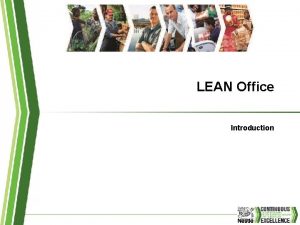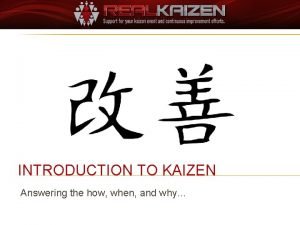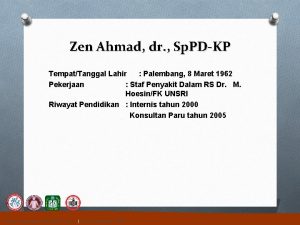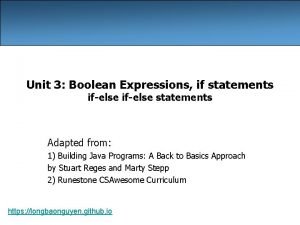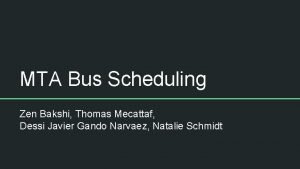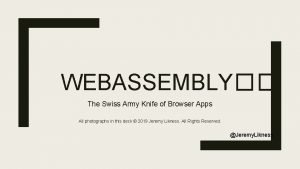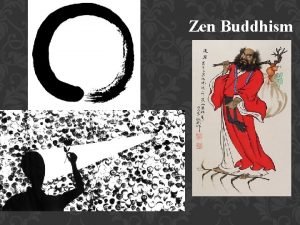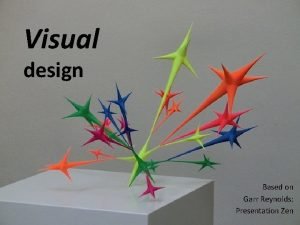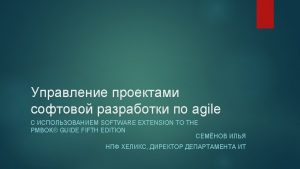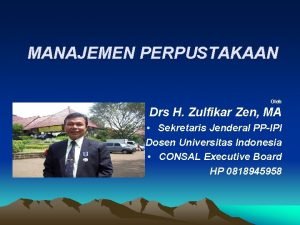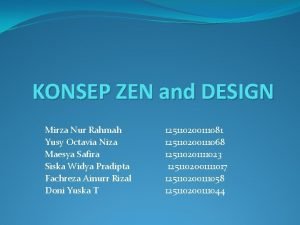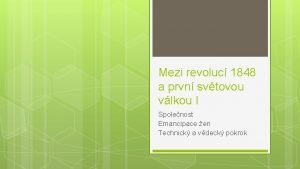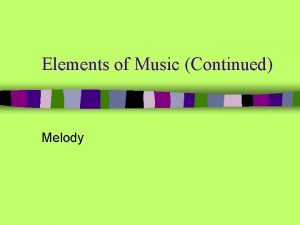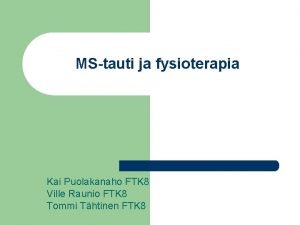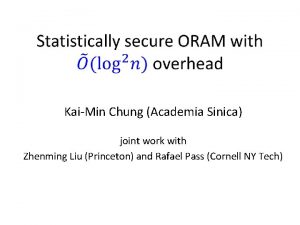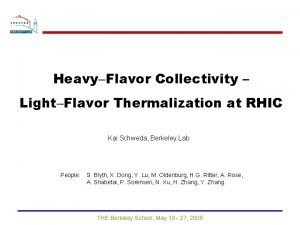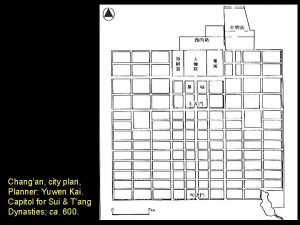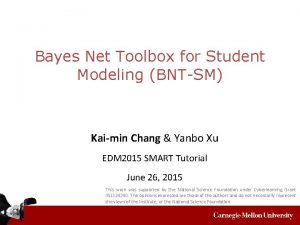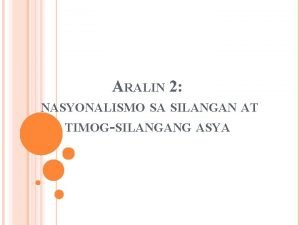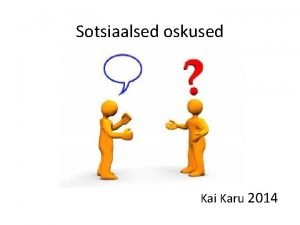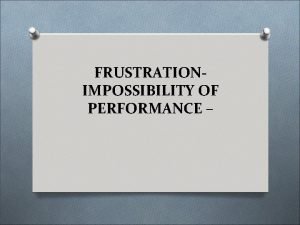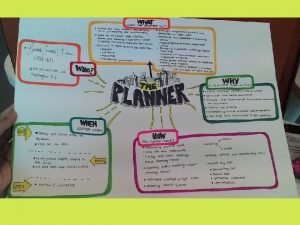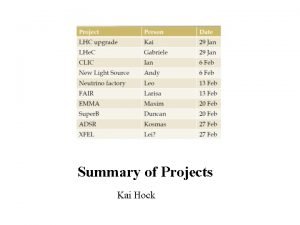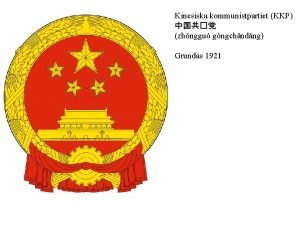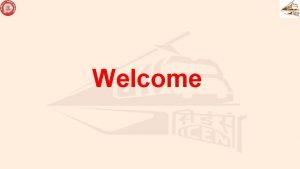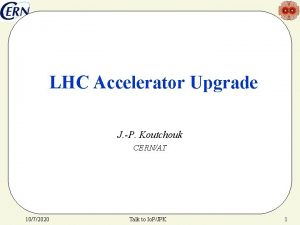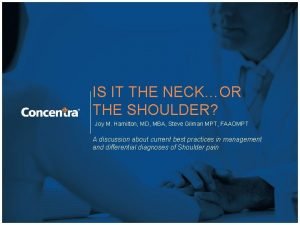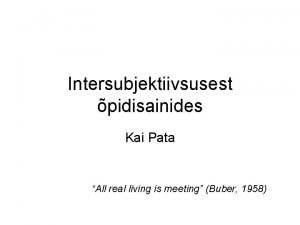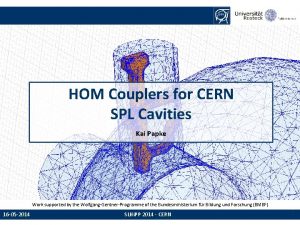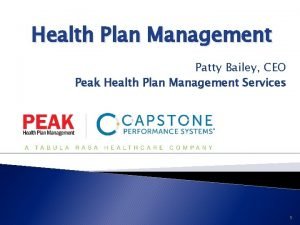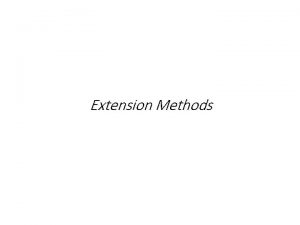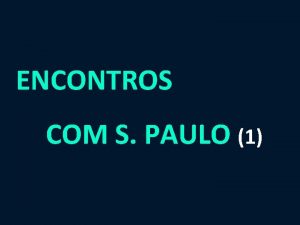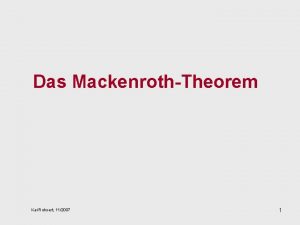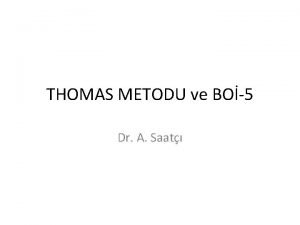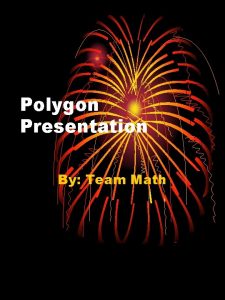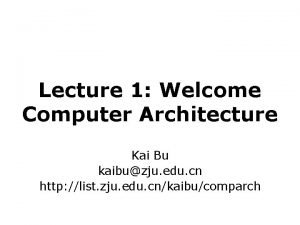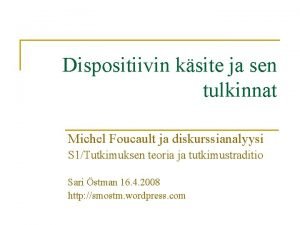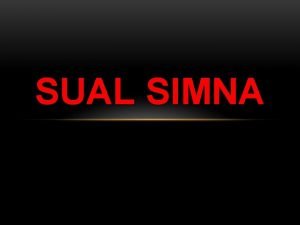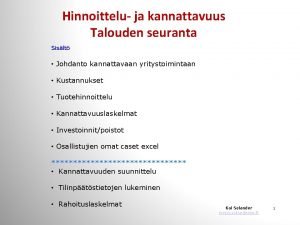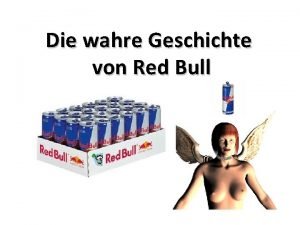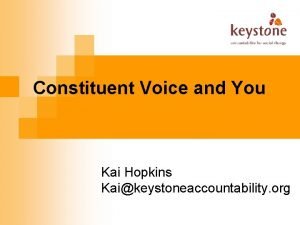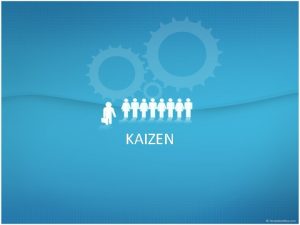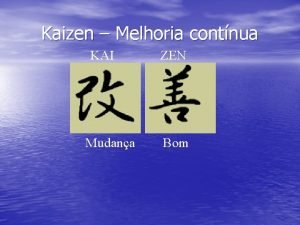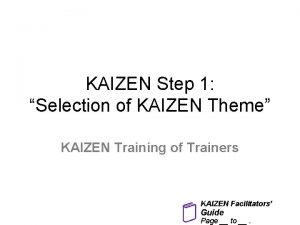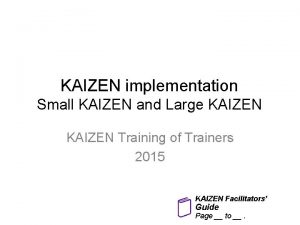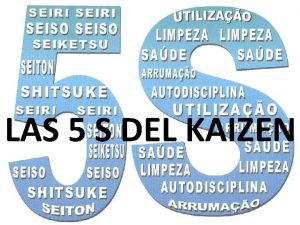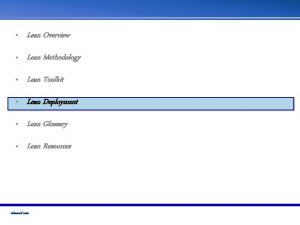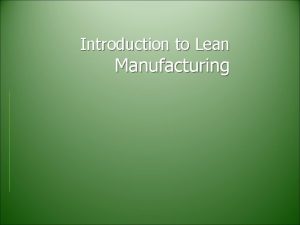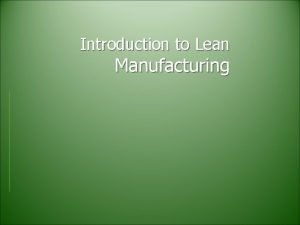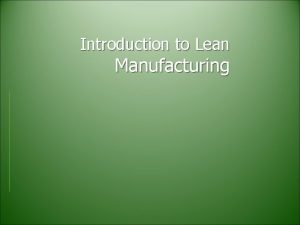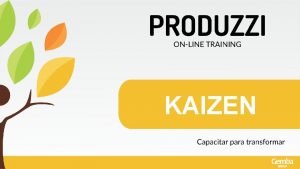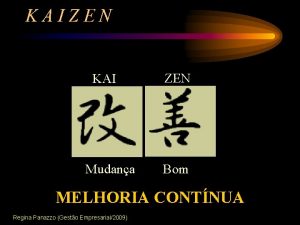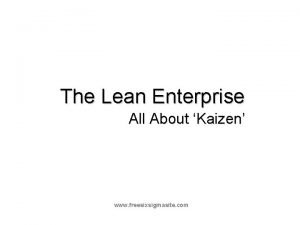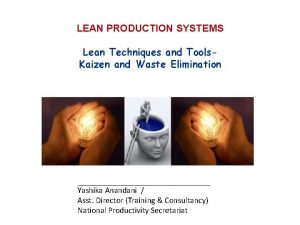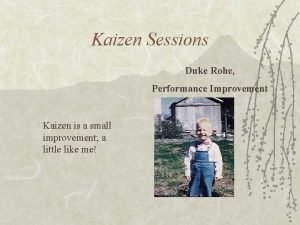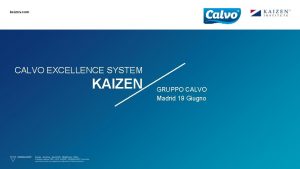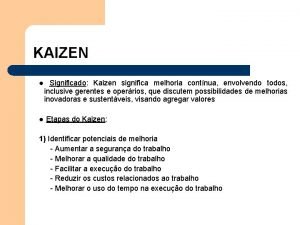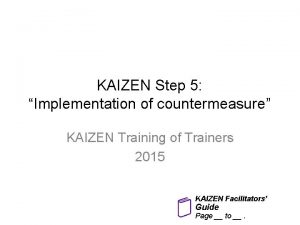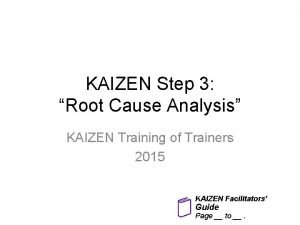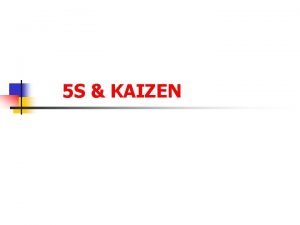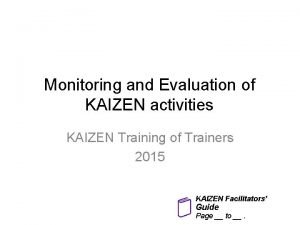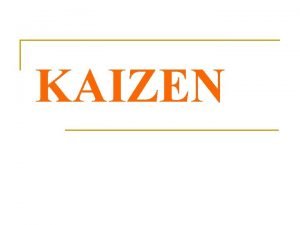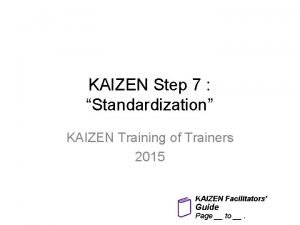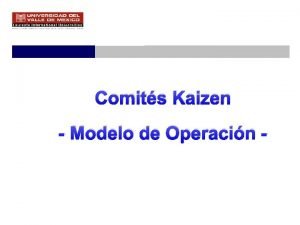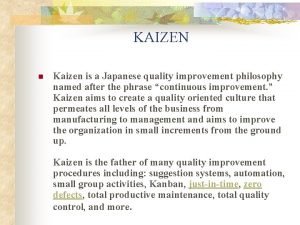LEAN Office Introduction KAIZEN Definition KAI Change ZEN




















![Losses in the Service Industry Work time Waiting time [h/year] Search time [h/year] Interruption Losses in the Service Industry Work time Waiting time [h/year] Search time [h/year] Interruption](https://slidetodoc.com/presentation_image/b56e189e579fdce36afddce479902e29/image-21.jpg)
![Losses in the Service Industry Work system environment [Euro] Clarity of information [h/year] Unclear Losses in the Service Industry Work system environment [Euro] Clarity of information [h/year] Unclear](https://slidetodoc.com/presentation_image/b56e189e579fdce36afddce479902e29/image-22.jpg)
![Losses in the Service Industry Business process Inventory [h/year] Handovers [h/year] Work procedure [h/year] Losses in the Service Industry Business process Inventory [h/year] Handovers [h/year] Work procedure [h/year]](https://slidetodoc.com/presentation_image/b56e189e579fdce36afddce479902e29/image-23.jpg)
![Losses in the Service Industry Employee Creativity [Number] Know how [Qualify] Health [h/year] Unused Losses in the Service Industry Employee Creativity [Number] Know how [Qualify] Health [h/year] Unused](https://slidetodoc.com/presentation_image/b56e189e579fdce36afddce479902e29/image-24.jpg)














































- Slides: 70

LEAN Office Introduction

KAIZEN Definition KAI Change ZEN for the better K A I Z E N = Continuous Improvement

Kaizen Principles Go to Gemba Office, workplace, server room Check Gembutsu Equipment, Material, Failures etc. Search for Muda (waste), Mura (inconsistency), Muri (physical strain) Make KAIZEN® Continuous Improvement

Why LEAN Office? Why do customers complain? % C U S T O M E R C O M P L A I N T 70% - Wrong date - Wrong place - Wrong part - Miscommunication - Billing errors - Poor service in general Service Quality - Dimensional errors - Functional errors - Surface defects? 30% Product Quality Source: DGQ, ASQC

Orientation Quality Zero defects Process Zero waste People Total involvement Customer Internal and external satisfaction Implementation Approach Just Do It!

Targets Q Quality S Speed P through - Standards - Customer satisfaction - Process control through - Less interfaces - Reduction of bottlenecks - Service Level Agreements Decrease costs through - More productivity - Better use of space - Lower office material costs Reduction of interfaces through - Qualified employees - Mobility Provide motivation through - More responsibility - More ideas and measures through - Environmental awareness - Ergonomics & health - Security Reduce mistakes/ errors Shorten the turn-around times Profitability F Flexibility I Innovation E Environment Create more responsibility

Total Service Management – Model Development Attitude/behavior Level 6 Entrepreneur Step -Takes responsibility -Prevents problems -Makes improvements Step Level 4 Step Initiative Level 3 Step Level 2 Step Level 1 Waiting for Direction -Indifferent -Reactive -Careless Step My Job Only - Coworker issues - individually focused - locally optomized - Simple viewpoint Level 5 Aspect Team - Department focused - Optimize workflow - Cooperative coverage Focus Total System - Team worker - Network - Global - Complex

Total Service Management – Model Development Gradual employment of the KAIZEN® Tools KAIZEN®Tools Step Problem solving story Policy Deployment Step 5 S SMED Policy Deployment Step Visuelles Management Process. Mapping Problem solving Value Stream Mapping KANBAN MUDA Process Mapping Step 5 S Standardization Awareness of MUDA KANBAN Standardization Value Stream Mapping

Results through Total Service Management Office material availability to 99% Reduction of searching time to 80% Increase in productivity over 50% Reduction of the turn-around time over 60% Space gain to 30%

Awareness of Waste Level 1

Waste and Losses Waste (Muda) in the processes Muda processes Process results in time loss for employees!

Kaizen Philosophy muda 12

Kaizen Philosophy muda 13

Kaizen Philosophy muda Don’t attack; it is Value Adding Attack this first !!! 14

Kaizen Philosophy 15

Work More Effective MUDA Work Add work and waste MUDA Work Better: MUDA Work MUDA 1. More time for customer‘s requests 2. Better planning and scheduling 3. Less stress

Study of Time Losses in the Office observed: weekly work time h % 40. 7 100% Gross work time In this time there are losses: Time losses due to Description Searching For documentation, files, all types of information Waiting For IT programmes, colleagues, signatures etc. Disruption Of the actual work through interruptions Pursuit Of missing information, colleagues who cannot be reached Staying In inefficient, too long meeting without results Sorting out Of excess information, advertising, e-mail, spam etc. Clarification Of badly delegated, unclear or confusing tasks Correcting Of incorrect, incomplete entries / Input Tracking Of complicated, redundant or bureaucratic processes Transporting Of papers from and to the copier, post, etc. Total time losses For the actual productive work there is only: Net work time h % Questionnaire Please imagine a fully normal working week. Estimate the “time-eaters”/”time-thieves” in the course of this working week. It is not important to have numbers exact to the minute but your own personal perception.

Study of Time Losses in the Office Specialists and managers say: Of the available work time an average of 38 percent is lost through unproductive activity. That means 15. 4 hours per week per employee! Survey method: Compare and estimate, E-mail survey Carried out by: KAIZEN-Institute Deutschland Schedule: October / November 2004 Target audience: Specialists and managers from Germany, Austria, Switzerland, Liechtenstein Sample: 583 persons, selected randomly Response / Response rate 181 responses -> 34 percent

Study of Time Losses in the Office : Results after Losses observed: weekly work time h Gross work time 40. 7 % 100% h % In this time there are losses: Time losses due to Description Rank Min Max Searching For documentation, files, all types of informationen 1. 5 3. 7% 4 0. 0 10. 0 Waiting For IT programmes, colleagues, signatures etc. 1. 5 3. 7% 5 0. 0 12. 0 Disruption Of the actual work through interruptions 2. 5 6. 2% 1 0. 0 11. 0 Pursuit Of missing information, colleagues who cannot be reached 1. 8 4. 5% 3 0. 0 15. 0 Staying In inefficient, too long meeting without results 2. 0 5. 0% 2 0. 0 Sorting out Of excess information, advertising, e-mail, spam etc. 1. 2 2. 9% 8 0. 0 13. 0 Clarification Of badly delegated, unclear or confusing tasks 1. 4 3. 5% 6 0. 0 10. 0 Correcting Of incorrect, incomplete entries / Input 1. 4 3, 4% 7 0. 0 12. 0 Tracking Of complicated, redundant or bureaucratic processes 1. 2 2. 8% 9 0. 0 10. 0 Transporting Of papers from and to the copier, post, etc. 0. 9 2. 3% 10 15. 4 38% 25. 3 62% Total time losses For the actual productive work there is only: Net work time 0. 0 8. 0 5. 0

Losses in the Service Industry The 16 types of losses in service industries Work time Work system Waiting time [h/year] environment Search time [h/year] Clarity of information [h/year] Interruption [h/year] Unclear targets [h/year] Technology [h/year] Information overload [h/year] Transportation [Euro] [h/year] Business process Employee Inventory [h/year] Creativity [Number] Handovers [h/year] Know how [Qualify] Work procedure [h/year] Health [h/year] Errors [h/year]
![Losses in the Service Industry Work time Waiting time hyear Search time hyear Interruption Losses in the Service Industry Work time Waiting time [h/year] Search time [h/year] Interruption](https://slidetodoc.com/presentation_image/b56e189e579fdce36afddce479902e29/image-21.jpg)
Losses in the Service Industry Work time Waiting time [h/year] Search time [h/year] Interruption [h/year]] Information overload [h/year] Transportation [h/year] Waiting for collegues, Decisions, Information, Material, Waiting through IT systems, IT-availibility, Non-reachable collegues Search for files, Paper stuff, Information, People, Office material Disruption for short not-known meetings, Collegues, Disruption thorugh noise, Environmental things (People, Optical), Phone, Technical availibilty Long meetings, Paper work, full tables, full harddisks, Archives, Binders, long time to keep information, Mailbox, incomplete Information, Advertisement, Rules Change in format (print, then fax), interfaces, Im- and Export files, Information cycles, Material, office layout, long ways, internal Post ways
![Losses in the Service Industry Work system environment Euro Clarity of information hyear Unclear Losses in the Service Industry Work system environment [Euro] Clarity of information [h/year] Unclear](https://slidetodoc.com/presentation_image/b56e189e579fdce36afddce479902e29/image-22.jpg)
Losses in the Service Industry Work system environment [Euro] Clarity of information [h/year] Unclear targets [h/year] Technology [h/year] Abundance of material (toners, catridges), very much paper, noise, no trash concept, trash is not sorted (Batteries, Toners), Energy, power, less car pool, Stand by missing Informationen, long decisions, consequent rules and procedures often checkbacks? , unclear responsibilities, many interfaces long searchtimes, doublework No policy deployment to the level of an employee, no personal targets, missing or unclear targets, less visualization, target conflicts, missing communication flow System error (Computer, Printer), defect equipment, Copy station, kitchen equipment, wrong or misson access (harddrive)
![Losses in the Service Industry Business process Inventory hyear Handovers hyear Work procedure hyear Losses in the Service Industry Business process Inventory [h/year] Handovers [h/year] Work procedure [h/year]](https://slidetodoc.com/presentation_image/b56e189e579fdce36afddce479902e29/image-23.jpg)
Losses in the Service Industry Business process Inventory [h/year] Handovers [h/year] Work procedure [h/year] Errors [h/year] High product depth for office material, development projects, Fear, open inquiry, Remains, no access, double filing Amout interfaces/handovers, missing process descriptions, Unclearness? , missing continuity, Data transfer mistake, Double input, manual Im- and Export, lacking responsibilities Formulars, missing Workflows, Distributor, missing training missing documentation, worse delegation, old processes, too much Bureaucracy Master data, parts lists, mistake in documents (Drawings, Calculations, offers), bad data quality, wrong documents, missing training, missing employee knowledge
![Losses in the Service Industry Employee Creativity Number Know how Qualify Health hyear Unused Losses in the Service Industry Employee Creativity [Number] Know how [Qualify] Health [h/year] Unused](https://slidetodoc.com/presentation_image/b56e189e579fdce36afddce479902e29/image-24.jpg)
Losses in the Service Industry Employee Creativity [Number] Know how [Qualify] Health [h/year] Unused creativity, missing idea management, less improvement workshops less Benchmark activities, Idea transfer/ -exchange, Month motto, missing culture, unused knowledge Documentation, Qualification matrix, from target to Qualification, regular Trainings, Process coaches, Deputy matrix, missing training, missing Transpareny, different information status Ergonomics, noise, light, narrowness, stress, spatial environment, missing active health care, month motto, actions

Study of Time Losses in the Office : Results after Losses 100% If the known time losses which are perceived as a burden are (only) halved, Productivity increases by approx. 30 percent. Losses 62% The losses still concealed in the actual productive work time open up further upwards potential! actual productive time 0% KAIZEN process

MUDA - Practice Paper stacks Searchtime < 30 seconds ? ?

Muda - Practice

The 5 S Campaign for Total Service Management Standardize Sustain Self-discipline Sort out Continous Improvement Scrub Straighten

Steps of the 5 S Campaign Seiri Seiso Shitsuke 1. Sort out 3. Scrub 5. Sustain Self-discipline 2. Straighten 4. Standardize Seiton Seiketsu

1. Seiri - Sort out and Separate Get rid of everything unnecessary! Old paper Analyse your workplace! Special rubbish “Red Tag“ campaign Scrap

2. Seiton - Straighten - Put in order so that they are ready when needed Provision of the necessary things in the right place What ? How much ? Where to ? What for ? Visual management Shadowboard for office utensils Area for putting things Markings / definition of volumes

3. Seiso - Scrub - Clean Workplace, Equipment and Prevent Defects Each employee cleans his work place and/or his tools himself. Benefit: Defects on devices and accessories are discovered in a timely manner Cleaning Check IT devices Cleaning is checking ! Drawers Cabinets Table surfaces Phone etc.

4. Seiketsu - Standardize - make sorting, straightening and scrubbing Standardisation through involvement of employees and their experiences - Office material - Brief descriptions (One Point Lesson) - Markings - Inscriptions - Paper supply - Toner and cartridge change Cleaning Check Reinigungs-Check ITEDV-Geräte devices Drawers Schubladen One Point Lesson Cupboards Schränke Table surfaces Tischoberflächen Phone Telefon etc. Office material sharing max. 1 m filling Eilt Stifte Activities Monday Tuesday Wednesday Thursday Friday Doku Kunden Aktuell Privat Search time max. 15 sec. Müll Ablage Papier

5. Shitsuke - Sustain - Self-discipline Prerequisite: Support of management and permanent training Representatives Responsibilities matrix We support the 5 S campaign !

Improvement Through Co-operation Level 2

What is a Standard? Improvements Wheel of the improvement Standard Quality consciousness Time The best, simplest and safest way to do something

Purpose of a Standard? Basis for training Maintenance of existing know-how Makes possible effective delegation Prevents errors Controls variability . . . in order to do something in the best, simplest and safest way.

Purpose of a Standard? Basis for audit or diagnosis Helps observance of quality, cost limits, dates of delivery (QCD) and security Defines critical specifications, requirements, processes Baseline for continuous improvement . . . in order to do something the best, simplest and safest way.

How Should Standards be Defined? Objectively Begin with the management of your team standards! Simply Clearly Next, educate the team on the need to improve the standard Accessible, available . . . so that it guarantees that something can be done in the best, simplest and safest way.

Standards in the Office File standards Meeting standard - Times - Procedures - Rules Work- and procedure standards Forms, Rules, expiration standards Service standards Information- and communication standards Material standards

Process Improvement Level 3

Introduction and Basics Actual situation Management by “throwing over the wall“

Introduction and Basics An “entrepreneur “

Introduction and Basics From the “department “ perspective to the process perspective

Introduction and Basics Flow oriented cooperation Everything flows!

Introduction and Basics Flow oriented cooperation Everything flows!

Introduction and Basics Flow oriented cooperation Everything flows!

Introduction and Basics Flow oriented cooperation Everything flows!

Introduction and Basics Flow oriented cooperation Everything flows!

Introduction and Basics Flow oriented cooperation Everything flows!

Introduction and Basics Flow oriented cooperation Everything flows!

Speak with Numbers, Data, Facts Net value is only what the customer is prepared to pay ! MUDA Customer desire Creation of value Customer satisfaction Process Measurable criteria in the process: • Ways • Distances • Frequency • Number of procedures • % distribution • Interruptions • Time • Cost • Process cost • Turnaround time • Idle time • Search time • Waiting time • Area • Errors • Staff satisfaction • Customer satisfaction

Customer and Supplier Relationships The process is at the center ! Preliminary process Subsequent process Information flow Supplier Customer Material or service flow Entrepreneur in the company

Improvement of Processes and Work Content (Process Mapping) Processes in the office are not visible and can often also not be clarified through observation Due to a lack of transparency staff often do not exactly know what their direct neighbor does In the office the processes firstly have to be made visible. For this purpose processes are first described by those involved and waste sought. Who ? does Mr. Bauer Unpacking material Ms. Meier what ? Checking delivery note Storing material Mr. Müller Ms. Schulz Booking inventory Disposing of packaging

Process Mapping Workshop in Practice

Process Mapping Workshop in Practice

Process Mapping Workshop in Practice

Process Mapping Workshop in Practice “We know we have a problem but we don‘t know where it is!“

Process-Mapping: Guide (1 -4)

Process-Mapping: Guide (5 -6)

Process-Mapping: Guide (7 -8)

Process-Mapping: Guide (9 -12)

Process Mapping: Assess Potential KAIZENLightning 1. Bottleneck Improvement potential Cost benefit analysis 150 hours p. a. Cost 2. Loop 450 hours p. a. 3 3. 15% errors 2 225 hours p. a. Total 825 hours p. a. 1 Benefit

Perspectives for Process Mapping 10, 000 m high: Observation of the entire company, possibly outside the company boundaries 1, 000 m high : Observation of a business process 100 m high : Observation of individual subprocesses

Customer and Supplier Relationships The “Entrepreneur in the Company“ Responsibility for: Qualities: Behavior: - product - quality - dates - costs - staff - entrepreneurial -visionary -decisive - communicative - risk friendly - market and customer oriented - economic - responsible - goal oriented - process oriented

Core statement Not only doing things right, but also doing the right things!

Core statement Every hour lost to a bottleneck is an hour lost to the whole company

Core statement The analysis of the problem shows the solution > To see means to comprehend <

To Consider: Analyze reasons for holding long-term stocks and think if the control of spare parts and materials should be in the scope as well: List of long-term stocks that include equipment and component models, specifications, order numbers, order months, expected month of use, stock months, months elapsed, quantities, and reasons for stocking Materials usage tables for calculating totals for different procurement systems, different equipment models, and so on

To Consider: Spare-parts control standards. Essential for assuring equipment reliability. On the other hand risks for unnecessary stocks: Classify and control spare parts , i. e. : Standby units – pumps, motors, and other standby equipment. The maintenance department should control and keep constantly ready for use Priority components – rotating parts of important machinery, etc. The maintenance department should control and check regularly General parts – regularly-issued items such as bearings, nuts, and bolts. The stores department should control, using a fixed-number system to issue items such as bearings, and the package/batch system to issue items such as nuts, bolts, and so on. Tools and testing equipment. The maintenance department should control tools and issue them on loan. Testing equipment should be controlled by the department that uses it.
 16 types of losses in tpm
16 types of losses in tpm Introduction to kaizen
Introduction to kaizen Zen ahmad
Zen ahmad Boolean zen
Boolean zen Zen bakshi
Zen bakshi Zen zulu
Zen zulu Github.com
Github.com The zen of python how to import
The zen of python how to import Zen in sanskrit
Zen in sanskrit Garr reynolds presentation
Garr reynolds presentation Crualing
Crualing Kartinah zen
Kartinah zen Zulfikar zen
Zulfikar zen Zen
Zen Fauziah zen
Fauziah zen Konsep zen
Konsep zen Emancipace žen 1848
Emancipace žen 1848 Melody tô bem, tô zen
Melody tô bem, tô zen Zen cult
Zen cult Ochránkyně žen a manželství
Ochránkyně žen a manželství Dongri
Dongri Kai nexus
Kai nexus Kai puolakanaho
Kai puolakanaho Kai game history
Kai game history Kai-min chung
Kai-min chung Kai correa infield drills
Kai correa infield drills Kai schweda
Kai schweda Pagoda almalik
Pagoda almalik Bayes net toolbox
Bayes net toolbox Nasyonalismo sa timog-silangang asya
Nasyonalismo sa timog-silangang asya En arche en ho logos
En arche en ho logos Kai karu
Kai karu Marcelijus martinaitis kai sirpsta vyšnios suvalkijoj
Marcelijus martinaitis kai sirpsta vyšnios suvalkijoj Reesi efert
Reesi efert Yong ung kai v enting case summary
Yong ung kai v enting case summary Mao tse-tung
Mao tse-tung Tee kai loon
Tee kai loon Kai hock
Kai hock Mark liberman
Mark liberman Chiang kai shek
Chiang kai shek Chiang kai shek
Chiang kai shek Justin trudeau antichrist
Justin trudeau antichrist Kai homs
Kai homs Dos moi pa sto, kai tan gan kinaso
Dos moi pa sto, kai tan gan kinaso Kai cernat
Kai cernat Visgi kartu ar atskirai
Visgi kartu ar atskirai Kai mcgreevy
Kai mcgreevy Kai pata
Kai pata Kai homs
Kai homs Pacelogic
Pacelogic Kai salta kates miega susirietusios kodel
Kai salta kates miega susirietusios kodel Kai metodu
Kai metodu Charis kai eirene
Charis kai eirene Mackenroth theorem
Mackenroth theorem Chiang kai-shek
Chiang kai-shek Pranas mašiotas kai aš mažas buvau pdf
Pranas mašiotas kai aš mažas buvau pdf Kai metodu
Kai metodu Karakia closing
Karakia closing Tetraconta kai octágono
Tetraconta kai octágono Marcelijus martinaitis kai sirpsta vyšnios suvalkijoj
Marcelijus martinaitis kai sirpsta vyšnios suvalkijoj Kai bu
Kai bu Nicole stockmann
Nicole stockmann Dispositiivi
Dispositiivi Kan kai
Kan kai Kokie hormonai išsiskiria kai žmogus sportuoja
Kokie hormonai išsiskiria kai žmogus sportuoja Kai poetschke
Kai poetschke Kaiwei chang
Kaiwei chang Mh seuranta
Mh seuranta Dietrich mateschitz kroate
Dietrich mateschitz kroate Kai hopkins
Kai hopkins Analisis chi square
Analisis chi square
